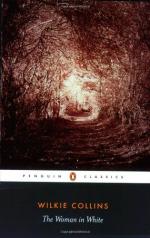12th.—A day of investigations and discoveries—a more interesting day, for many reasons, than I had ventured to anticipate.
I began my sight-seeing, of course, with the house.
The main body of the building is of the time of that highly-overrated woman, Queen Elizabeth. On the ground floor there are two hugely long galleries, with low ceilings lying parallel with each other, and rendered additionally dark and dismal by hideous family portraits—every one of which I should like to burn. The rooms on the floor above the two galleries are kept in tolerable repair, but are very seldom used. The civil housekeeper, who acted as my guide, offered to show me over them, but considerately added that she feared I should find them rather out of order. My respect for the integrity of my own petticoats and stockings infinitely exceeds my respect for all the Elizabethan bedrooms in the kingdom, so I positively declined exploring the upper regions of dust and dirt at the risk of soiling my nice clean clothes. The housekeeper said, “I am quite of your opinion, miss,” and appeared to think me the most sensible woman she had met with for a long time past.
So much, then, for the main building. Two wings are added at either end of it. The half-ruined wing on the left (as you approach the house) was once a place of residence standing by itself, and was built in the fourteenth century. One of Sir Percival’s maternal ancestors—I don’t remember, and don’t care which—tacked on the main building, at right angles to it, in the aforesaid Queen Elizabeth’s time. The housekeeper told me that the architecture of “the old wing,” both outside and inside, was considered remarkably fine by good judges. On further investigation I discovered that good judges could only exercise their abilities on Sir Percival’s piece of antiquity by previously dismissing from their minds all fear of damp, darkness, and rats. Under these circumstances, I unhesitatingly acknowledged myself to be no judge at all, and suggested that we should treat “the old wing” precisely as we had previously treated the Elizabethan bedrooms. Once more the housekeeper said, “I am quite of your opinion, miss,” and once more she looked at me with undisguised admiration of my extraordinary common-sense.
We went next to the wing on the right, which was built, by way of completing the wonderful architectural jumble at Blackwater Park, in the time of George the Second.
This is the habitable part of the house, which has been repaired and redecorated inside on Laura’s account. My two rooms, and all the good bedrooms besides, are on the first floor, and the basement contains a drawing-room, a dining-room, a morning-room, a library, and a pretty little boudoir for Laura, all very nicely ornamented in the bright modern way, and all very elegantly furnished with the delightful modern luxuries. None of the rooms are anything like so large and airy as our rooms at Limmeridge,




